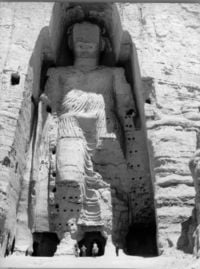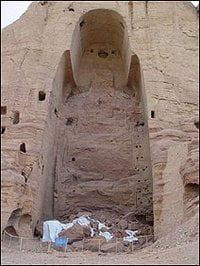Destruction of Bamian Buddha Statues
Source: Wikipedia
GNU Free Documentation License

Click image for larger photo.
When Mahmud of Ghazni conquered Afghanistan in the 12th century, the Buddhas and frescoes were spared from destruction. Still, over the years Muslim iconoclasts hacked away at some of the statues’ details, mostly the facial features and hands. Aurangzeb, the last Mughal emperor distinguished for his religious zeal, employed heavy artillery in an attempt to destroy the statues. Genghis Khan and Nadir Shah too had cannon fire directed at the statues. But over the centuries the statues had largely been left untouched.
In July 1999, Mullah Mohammed Omar issued a decree in favor of the preservation of the Bamiyan Buddhas.
Because Afghanistan’s Buddhist population no longer existed, which removed the possibility of the statues being worshipped, he added: “The government considers the Bamiyan statues as an example of a potential major source of income for Afghanistan from international visitors. The Taliban states that Bamiyan shall not be destroyed but protected.”
Afghan’s Islamist clerics would begin a campaign to crack down on “un-Islamic” segments of Afghan society. The Taliban soon banned all forms of imagery, music and sports, including television. There is reason to believe that this was in accordance with a strict interpretation of Islamic law.
In March 2001, according to Agence France Presse in Kabul, the decree declared, “Based on the verdict of the clergymen and the decision of the Supreme Court of the Islamic Emirate (Taliban) all the statues around Afghanistan must be destroyed. All the statues in the country should be destroyed because these statues have been used as idols and deities by the non-believers before. They are respected now and may be turned into idols in future too. Only Allah, the Almighty, deserves to be worshipped, not anyone or anything else.”
Information and Culture Minister Qadratullah Jamal told Associated Press of a decision by 400 religious clerics from across Afghanistan declaring the Buddhist statues against the tenets of Islam. “They came out with a consensus that the statues were un-Islamic,” said Jamal.
On March 6, the London Times quoted Mullah Mohammed Omar as stating, “Muslims should be proud of smashing idols. It has given praise to God that we have destroyed them.” He had clearly changed his position from being in favor of the statues to being against them. During a March 13 interview for Japan’s Mainichi Shimbun, Foreign Afghan Minister Wakil Ahmad Mutawakel stated that the destruction was anything but a retaliation against the international community for economic sanctions: “We are destroying the Buddha statues in accordance with Islamic law and it is purely a religious issue”.
On March 18, The New York Times reports, that a Taliban envoy said the Islamic government made its decision in a rage after a foreign delegation offered money to preserve the ancient works while a million Afghans faced starvation. The New York Times also added, however, that other reports “have said the religious leaders were debating the move for months, and ultimately decided that the statues were idolatrous and should be obliterated.”

Then Taliban Ambassador-at-large, (and current Yale student) Sayed Rahmatullah Hashemi, said that the destruction of the statues was carried out during the famine in Afghanistan after a Swedish government earmarked money to be provided to restore the statues and refused to allow it to be used to aid Afghan Children. Hashimi is reported as saying: “When the Afghani head council asked them to provide the money to feed the children instead of fixing the statues, they refused and said, ‘No, the money is just for the statues, not for the children’. Herein, they made the decision to destroy the statues”
On April 19th 2004, in an interview to a Pakistani journalist Mohammad Shehzad, Mullah Mohammad Omar said the following, “I did not want to destroy the Bamiyan Buddha.
In fact, some foreigners came to me and said they would like to conduct the repair work of the Bamiyan Buddha that had been slightly damaged due to rains. This shocked me. I thought, these callous people have no regard for thousands of living human beings – the Afghans who are dying of hunger, but they are so concerned about non-living objects like the Buddha. This was extremely deplorable. That is why I ordered its destruction. Had they come for humanitarian work, I would have never ordered the Buddhas’ destruction.”
The Islamist Taliban government decreed that the statues, which had survived intact for over 1,500 years, were idolatrous and un-Islamic. During the destruction, Taliban Information Minister Qudratullah Jamal lamented that, “this work of destruction is not as easy as people might think. You can’t knock down the statues by shelling as both are carved into a cliff; they are firmly attached to the mountain.” The two largest Buddhas faced dynamite and tank barrages and were demolished after almost a month of intensive bombardment.
Calendar commemorating the destructionAccording to UNESCO Director-General Koïchiro Matsuura, a meeting of ambassadors from the 54 member states of the Organisation of the Islamic Conference (OIC) was conducted. All OIC states – including Pakistan, Saudi Arabia and the United Arab Emirates, three countries that officially recognised the Taliban government – joined the protest to spare the monuments (CNN). A statement issued by the ministry of religious affairs of Taliban regime justified the destruction as being in accordance with Islamic law [AFP News]. Saudi Arabia and the United Arab Emirates would later condemn the destruction as “savage.” A Swiss documentary reported that locals claimed to have seen Pakistani and Saudi engineers on site to help with the destruction of the statues.[5]. A Pakistani charity, Al Rasheed Trust, based in Karachi, had published a special calendar with photographs of the destructions to commemorate the destruction.

